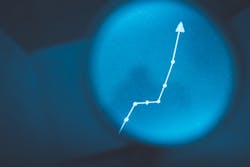Once again, laser diodes are peering over the horizon in the Li-Fi business, as France’s Oledcomm has outlined a leading role that the chips will play in delivering exponentially faster speeds than do today’s LEDs.
But the company also believes that LEDs will continue to serve Li-Fi, the optical communication technology in which modulated visible light or infrared delivers data to gadgets and laptops as an alternative to today’s ubiquitous radio-based Wi-Fi.
Today, LEDs account for virtually all of the commercial installations. But Li-Fi market adoption has crawled, and pundits believe that faster speeds provided by lasers could stimulate uptake.
"Yes, I think lasers have a clear role to play, I’m absolutely convinced about that," Azoulay told LEDs Magazine in a recent interview.
He cited speed as the main reason to use lasers. As LEDs Magazine has been reporting, lasers trump LEDs hands down in that department. For example, when Santa Barbara, Calif.–based laser maker Kyocera SLD Laser (KSLD) demonstrated laser Li-Fi at last January’s CES in Las Vegas, it delivered 100 Gbps, which at the time was 100 times faster than any LED Li-Fi demo, and probably around 600 to 700 times faster than the fastest commercially deployed LED Li-Fi. (Although Li-Fi enthusiasts sometimes claim that it is faster than Wi-Fi, in real-world deployments of LED Li-Fi, the rates can often be not much faster than Wi-Fi.)
Azoulay’s new partner in the executive suite, co-CEO Pierre-Jean Beylier, shares the laser vision, so to speak.
“Laser is definitely a technology we started working on, and I think you will see us developing laser-based solutions sooner rather than later,” he told LEDs in the same interview.
In fact, Oledcomm, based outside of Paris in Vélizy-Villacoublay, quietly launched its laser efforts back in January 2021 when, at that year’s CES consumer electronics exhibition, it introduced a system called LiFiMAX1G rated at around 1 Gbps, well above prevailing Wi-Fi rates.
What it did not say at the time was that the product’s design is centered around a laser chip, not an LED. In our recent interview, Azoulay revealed that lasers are at the system’s core.
At the CES introduction nearly two years, Oledcomm said it would position the system for machine-to-machine, robotic, and Internet-of-Things (IoT) communications in factory settings, where it can work at distances of up to 5 m — comparatively short distances, and not really a consumer proposition.
The company seems to have found some users, at least on a trial basis, and perhaps more.
“We are using it for point-to-point communications at a distance of between one and five meters, and we have some use cases, especially in industry,” Azoulay said.
He declined to identify the users, and the installations appear to be small scale. But the Oledcomm co-CEO said the company would say more about lasers at the upcoming CES 2023 in early January.
Meanwhile, mass adoption of Li-Fi continues to be elusive, as gadget makers have yet to embed the technology the way they do with Wi-Fi, and a standards debate remains unsettled.
Oledcomm is not alone among Li-Fi vendors in seeing a future in lasers. A year ago, Edinburgh, Scotland–based Li-Fi pioneer pureLiFi told LEDs that “laser light will better serve Li-Fi.” PureLiFi’s co-founder and chief scientific officer Harald Haas — regarded as the father of Li-Fi — also now serves as a strategic adviser to KSLD, the laser maker. About three years ago he articulated a future in which Li-Fi speeds could hit a terabit per second through the use of lasers, by the middle of this decade (although that time scale at this point might seem unlikely).
On the chip level, KSLD is not the only vendor eyeing laser diodes for Li-Fi. Cree LED could well head in that direction too, the CEO of Cree parent SGH Holdings told LEDs earlier this year.
But that is not to say that LEDs will fade away from the Li-Fi scene. Oledcomm, which uses infrared LEDs rather than visible light LEDs, is not discarding them. Next: LEDs Magazine will bring you the company’s thoughts on how LEDs and lasers will share the Li-Fi duty. Teaser: there is an eye-catching angle.
MARK HALPER is a contributing editor for LEDs Magazine, and an energy, technology, and business journalist ([email protected]).
For up-to-the-minute LED and SSL updates, follow us on Twitter. You’ll find curated content and commentary, as well as information on industry events, webcasts, and surveys on our LinkedIn page and our Facebook page.

Mark Halper | Contributing Editor, LEDs Magazine, and Business/Energy/Technology Journalist
Mark Halper is a freelance business, technology, and science journalist who covers everything from media moguls to subatomic particles. Halper has written from locations around the world for TIME Magazine, Fortune, Forbes, the New York Times, the Financial Times, the Guardian, CBS, Wired, and many others. A US citizen living in Britain, he cut his journalism teeth cutting and pasting copy for an English-language daily newspaper in Mexico City. Halper has a BA in history from Cornell University.






